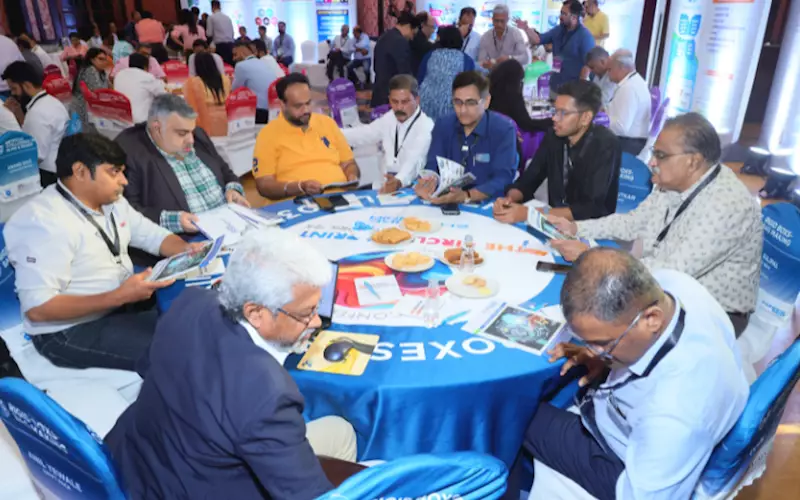MMS roundtable: Rigid box, a potentially growth sector in India
The Mumbai Mudrak Sangh roundtable (RT) discussed the benefits of implementing automation in producing rigid boxes and bags and how it can help companies stay competitive. And what trends are emerging in rigid boxes and paper bags in the post-pandemic era ...
08 Apr 2024 | By Noel D'Cunha
Rohit Rajpal, managing director of Zhongke, who was also the expert at the RT shared information about the usage patterns in rigid boxes. He said, “Rigid boxes are deployed in various industries and applications where a durable, high-quality packaging solution is required. The sturdy construction of these boxes makes them a popular choice for packaging high-value and premium products across a range of industries.”
Some uses of rigid boxes include packaging luxury goods, such as high-end cosmetics, perfumes, jewellery, watches, and designer clothing. They are used for packaging electronic devices, such as smartphones, tablets, laptops, cameras, and high-end audio equipment, to provide protection during shipping while creating a premium unboxing experience for customers. “In India, even the local halwai uses such boxes, albeit of a low quality,” informed Rajpal.
Rajpal’s Zhongke India, which is in its tenth year of service in India, among the six Chinese manufacturers it represents, handles Zhongke (Zhejiang Zhongke Packaging Machinery) for rigid box manufacturing machines in India and neighbouring countries.
The size of the rigid box industry in India was discussed. Rajpal said it’s tough to gauge the size because there are many unorganised players (over 50%). However, a rough calculation was made based on the number of players. Rajpal informed us that there may be around 20-25 A-lister players in the organised sector among 1,000 players. The A-listers produce jobs of one lakh and above high-quality rigid boxes, and the other players produce 5,000 and under. “The 20-25 Indian rigid box manufacturers use automated set-up,” informed Rajpal.
The size of the rigid box industry in India would be close to Rs 20,000 crore. This includes, both the organised and unorganised sectors. Zhongke India has 650 machines and garners a market share of 60%. Overall, Zhongke has sold over 5,000 machines all over the world and holds more than 50% of the rigid box industry.
The RT members discussed trends in the rigid box industry. Some of the current trends in rigid box manufacturing include using sustainable and eco-friendly materials, innovative designs that incorporate unique shapes and functionality, and integrating technology such as RFID chips for tracking and inventory management. Additionally, he said, there is a growing demand for personalised and customised rigid boxes that cater to specific customer needs and preferences. “As e-commerce continues to grow, there is a trend towards developing packaging solutions that offer better product protection during shipping and handling,” said Rajpal.
He added, “Today, we also see child safety boxes, food contamination boxes to eliminate the migration of inks or coating, refrigeration safe, rigid boxes, and all-weather boxes.”
The members on the RT table were mostly converters who produced limited quantities of rigid boxes except two, manufacturing 15,000-17,000 boxes per day, while one produced 100-200 high-quality boxes manually.
To a question about the key benefits of implementing automation in the production of rigid boxes and bags and how it can help companies stay competitive in the market, Rajpal replied, “There are many. Increased efficiency, consistent quality, cost savings, flexibility and customisation, inventory management, adaptability to market trends, and improved safety and compliance.”
He explained, “One member is manufacturing 100 boxes. If he has an automatic or semi-automatic machine, he would be in a position to cater to more clients by ganging the jobs.” He added, “The cause of most rejections comes from finger marks, bubbles on the edge of the boxes, or just the finish of the edges. One can eliminate these issues.”
There’s another advantage. Automation will help customer retention. “In this era of just-in-time, having space capacity is helpful. A customer does not like to wait. If you cannot deliver his requirements, he will go to the next supplier, who may be better prepared to even cater to all of his requirements. There’s a chance of losing customers in such cases.”
So, what should be his first step if someone is looking to enter the rigid box business? “Buy a sample-maker, and learn the tricks of producing a perfect box. The next steps will automatically fall in line,” advised Rajpal.
Participants
- Industry expert: Rohit Rajpal, Zhongke India
- Delegates: Chintakk Savla, Super Creative, Mumbai
Fenil Shah, V-Pack, Vasai
Sanjay Patil, Ganesh Mundra, Mumbai
Sachin Hadavale, Sunshine Creation, Mumbai
Rajan Parekh, Onus Impression, Mumbai
Rohit, Creative Packaging, Nashik
Anil Yewle, Swift Multiprint & Pack, Mumbai
Rohit Rajpal’s takeaways
The rigid box industry constantly evolves, with new trends emerging yearly. Some of the current trends in rigid box manufacturing include deployment of sustainable and eco-friendly materials, innovative designs that incorporate unique shapes and functionality, and integrating technology such as RFID chips for tracking and inventory management.
Additionally, a growing demand for personalised and customised rigid boxes that cater to specific customer needs and preferences is growing. As e-commerce continues to grow, there is also a trend towards developing packaging solutions that offer better product protection during shipping and handling.
Overall, the rigid box industry adapts to changing market demands and embraces new technologies to deliver high-quality, sustainable packaging solutions.











 See All
See All